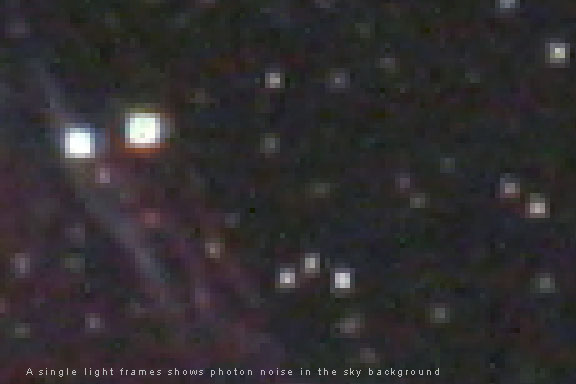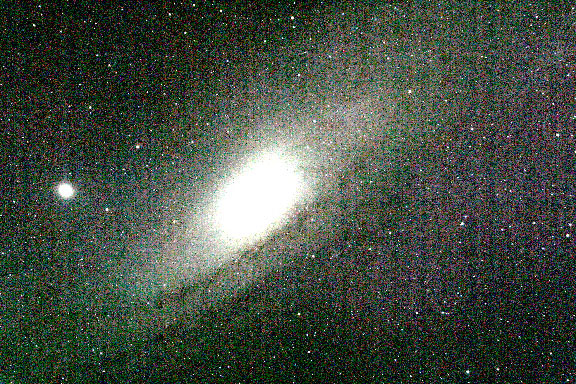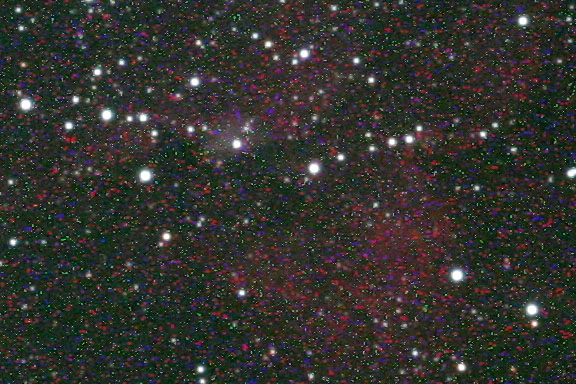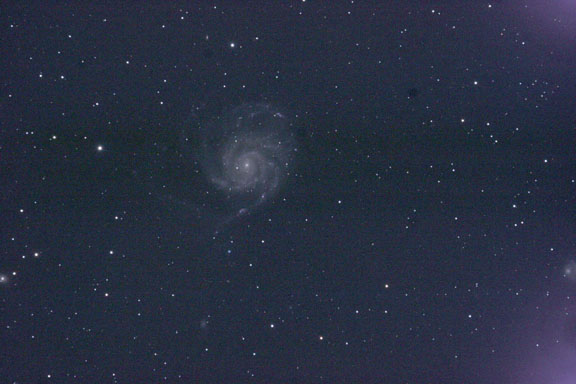True Noise
True noise in an image is random. It can come from various sources inside the camera including readout noise, and quantization noise. It also comes from photon noise from the object, sky background, and thermal signal.
Other things in an image can look like noise, but are really not, such as thermal signal and amp glow.
Mouse-Over

|
|
Random photon noise is visible in this image of a single light frame. It is reduced by stacking multiple light frames. Hold your mouse cursor over the image to see the comparison. These images have been enlarged to 500 percent to make the noise more visible. Both images have been calibrated with a master dark frame.
|
- Solution: Increase the signal. The source of the noise doesn't really matter since there isn't much we can do about it anyway because of its random nature. But we can always improve an image by increasing its signal-to-noise ratio. We do this by gathering more photons, which make up the signal, to increase the signal part of the signal-to-noise ratio. When the signal in multiple light frames is averaged, the photon noise in the sky background is reduced.
Banding
Images can sometimes display vertical or horizontal banding. Sometimes it is from true noise in the camera which is random and varies from frame to frame. Sometimes it repeats in a pattern.
Sometimes banding is caused by electrical interference, and sometimes it is just from a defective camera.

|
|
Vertical banding and noise can be seen in this image of M31, the Andromeda Galaxy.
|
- Solution:
- Increase the signal. Use longer exposure in each sub frame.
- Dithering can also help with pattern noise. Dithering means moving the scope randomly a little bit between each image. We frequently get some dithering naturally if we are not guiding because the frame will move a little bit each exposure from periodic error and flexure.
- Check for sources of electrical interference, such as motors, inverters or other electronic devices, running nearby.
- For a defective camera, return the camera to the manufacturer for a replacement.
Signal That Looks Like Noise: Thermal Signal
Thermal signal comes from electrons which are released by heat in the camera. The sensor is so sensitive that it records these electrons as signal. This signal is consistent from frame to frame, although it does vary in intensity with temperature and exposure time.
Thermal signal looks like hot pixels and color blotches across the image. In the image below, the hot pixels look like little grains of sand sprinkled across the image.

|
|
Thermal signal is seen in the form of hot pixels and red, blue and green colored blotches.
|
- Solution:
- Subtract a dark frame. If you are shooting just a few JPEG frames, use in-camera long-exposure noise reduction. If you are shooting multiple light frames for stacking, shoot separate dark frames to create a master dark frame to use in calibration.
Signal That Looks Like Noise: Amp Glow
Amp Glow is a red glow in the corners and edges of a long exposure image caused by electrons in transistors in the readout amplifier of the camera's sensor. Amp glow is not caused by heat, it is caused by electroluminescence.
In the image below we can see amp glow in the upper and lower right corners of the frame.

|
|
Amp Glow is seen in the upper and lower right corners of this image of galaxy M101.
|
- Solution:
- Subtract a dark frame taken at the same exposure, ISO and temperature as the light frame. The dark frame should contain the same amount of amp glow as the light fame.
- Buy a new DSLR camera. Most new cameras by Canon and Nikon turn off the readout amplifier during long exposures and do not suffer from the problem of amp glow.
|
Problem: Noise - The Bottom Line
Noise in an image is random, and can come from several sources. Some things can look like noise, such as thermal signal, but are really not.
Noise can't be totally removed, but it's impact can be reduced.
The best way to deal with true noise is by improving the signal-to-noise ratio by recording more signal by stacking light frames or using longer exposures.
|